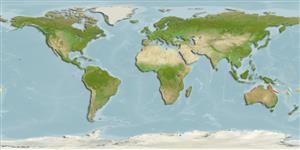>
Ovalentaria/misc (Various families in series Ovalentaria) >
Pomacentridae (Damselfishes) > Pomacentrinae
Etymology: Pomacentrus: Greek, poma, -atos = cover, operculum + Greek, kentron = sting (Ref. 45335); magniseptus: Named for the Great Barrier Reef (Latin 'magniseptus' for great-barrier) geographic distribution; noun in apposition..
Environment: milieu / climate zone / depth range / distribution range
Ecologie
marien rifbewoner; diepte 2 - 12 m (Ref. 114927). Tropical; 11°S - 24°S (Ref. 114927)
Western Pacific: Australia.
Grootte / Gewicht / Leeftijd
Maturity: Lm ? range ? - ? cm
Max length : 7.6 cm SL mannelijk / geslacht onbekend; (Ref. 114927)
Korte beschrijving
Morfologie | Morfometrie
Dorsale stekels (totaal): 13; Dorsale zachte stralen (totaal): 13-15; Anale stekels 2; Anale zachte stralen: 13 - 15; Wervels: 26. This species is distinguished by the following characters: D XIII,13-15 (usually 14); A II,13-15 (usually 14); pectoral-fin rays 17-19 (usually 18); tubed lateral-line scales 16-19 (usually 18); total gill rakers on first arch 21-24 (usually 23); body depth 1.9-2.1 in SL; usually scales are absent on preorbital and suborbital, except occasional scales on posterior part of suborbital; general colour in life charcoal gray with thick blackish scale margins producing a network pattern and a vertically ovate whitish spot centered on each scale, forming rows that correspond with horizontal scale rows; pectoral-fin base with a large black spot , invading outer part of axil; inner surface of pectoral-fin axil grayish; median fins are charcoal gray to blackish; dorsal scleral surface of eye bright blue. This species differs from other members of the philippinus species complex by having a distinctive color pattern, with horizontal rows of whitish spots on the side of the body made up of the pale centers of the distinctly outlined scales and it is always lacking scales on the preorbital and most of the suborbital (occasional specimens, however, possess 1-3 scales on the posteriormost section of the suborbital) (Ref. 114927).
Usual habitat consists of passages and outer reef slopes in about 1.5-12 m, adjacent to vertical walls or in the shadows of overhanging cliffs and ledges (Ref. 114927).
Levenscyclus en paargedrag
Maturiteit | Voortplanting | Paaien | Eieren | Fecunditeit | Larven
Allen, G.R., M.V. Erdmann and P.D. Pertiwi, 2017. Descriptions of four new species of damselfishes (Pomacentridae) in the Pomacentrus philippinus complex from the tropical western Pacific Ocean. J. Ocean Sci. Found. 25:47-76. (Ref. 114927)
Status op de Rode Lijst van het IUCN (Ref. 130435)
Gevaar voor de mens
Harmless
Gebruik door de mens
Meer informatie
Lokale namenSynoniemenMetabolismePredatorenEcotoxicologieVoortplantingMaturiteitPaaienPaaiaggregatiesFecunditeitEierenOntwikkeling van de eieren
Leeftijd/GrootteGroeiLengte-gewichtLengte-lengteLengtefrequentiesMorfometrieMorfologieLarvenLarvale populatiedynamiekRekruteringAbundantieBRUVS
ReferentiesAquacultuurAquacultuurprofielKweeklijnenGeneticaElectrophoresesErfelijkheidZiektesVerwerkingNutrientsMassaconversie
Tools
Speciale rapporten
Download XML
Internetbronnen
Estimates based on models
Fylogenetische diversiteitsindex (Ref.
82804): PD
50 = 0.5000 [Uniqueness, from 0.5 = low to 2.0 = high].
Bayesian length-weight: a=0.02399 (0.01139 - 0.05051), b=2.98 (2.81 - 3.15), in cm total length, based on LWR estimates for this Genus-body shape (Ref.
93245).
Trofisch niveau (Ref.
69278): 2.7 ±0.3 se; based on size and trophs of closest relatives
Weerstandsvermogen (Ref.
120179): Hoog, minimale populatieverdubbelingstijd minder dan 15 maanden (Preliminary K or Fecundity.).
Fishing Vulnerability (Ref.
59153): Low vulnerability (10 of 100).
Nutrients (Ref.
124155): Calcium = 153 [74, 245] mg/100g; Iron = 0.864 [0.514, 1.504] mg/100g; Protein = 18 [17, 19] %; Omega3 = 0.106 [0.060, 0.181] g/100g; Selenium = 19.3 [10.2, 39.0] μg/100g; VitaminA = 99.2 [24.9, 361.1] μg/100g; Zinc = 2.21 [1.47, 3.35] mg/100g (wet weight);
